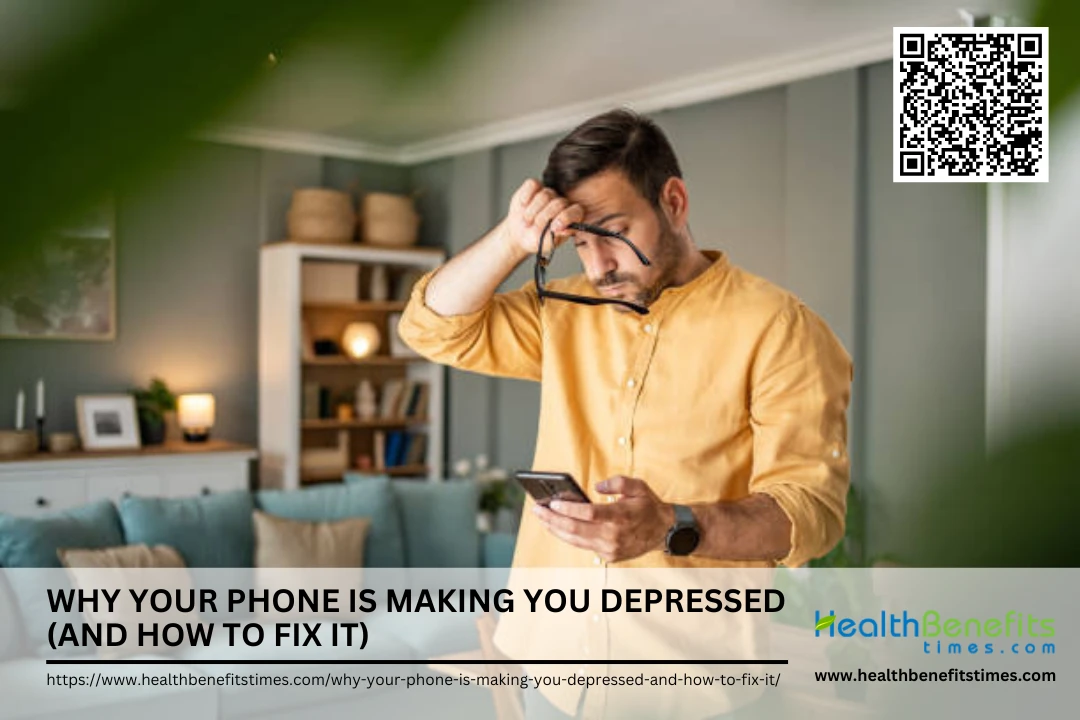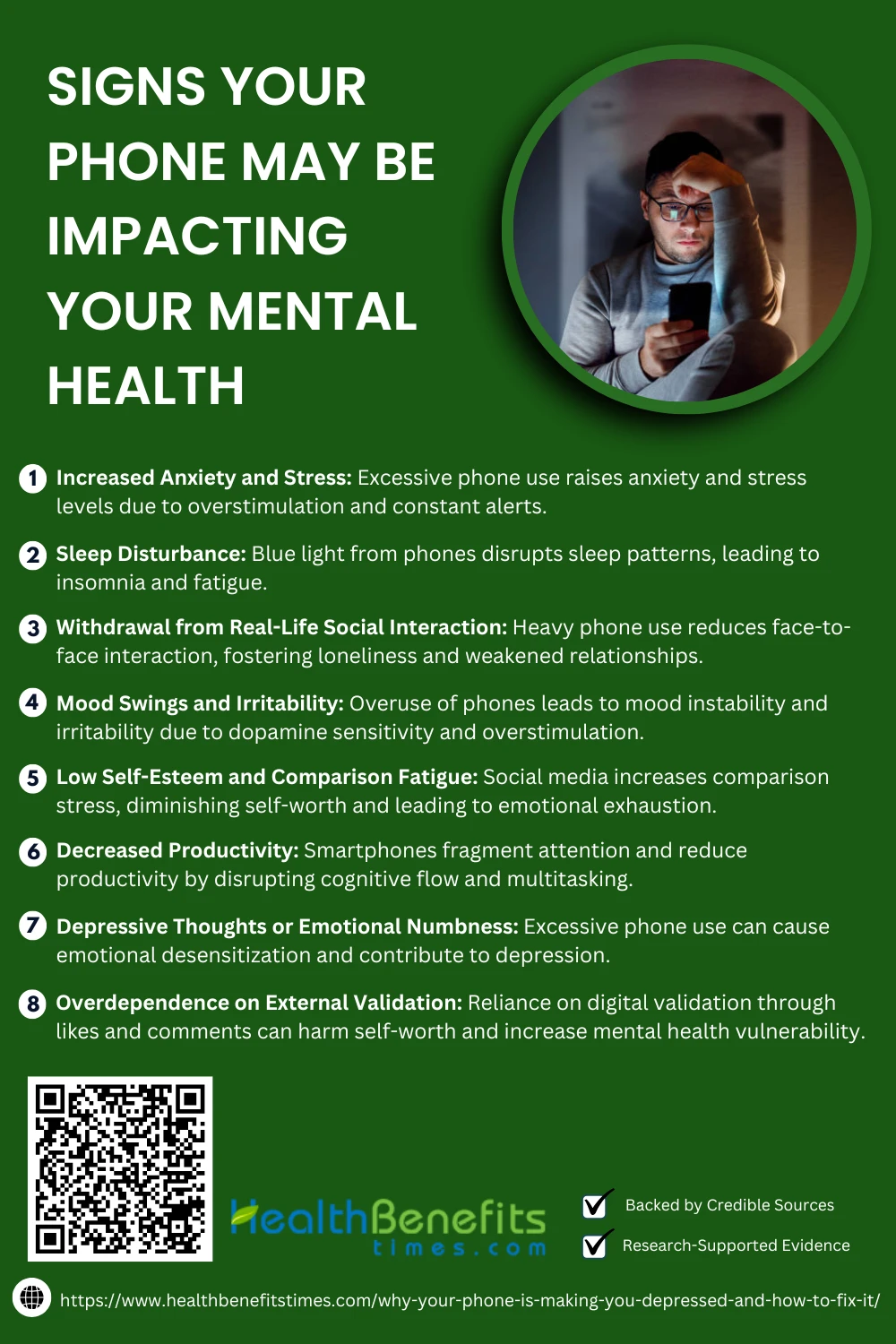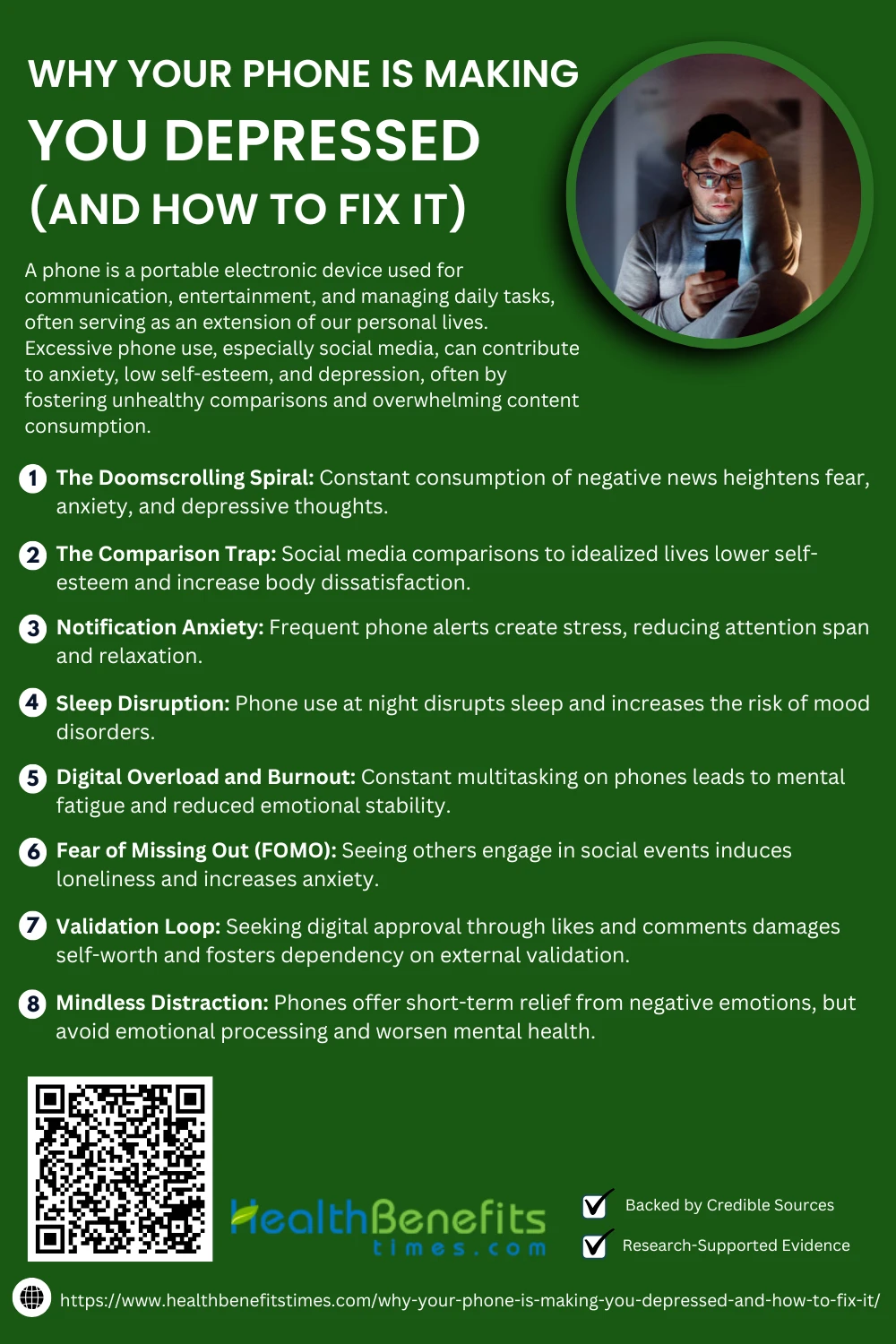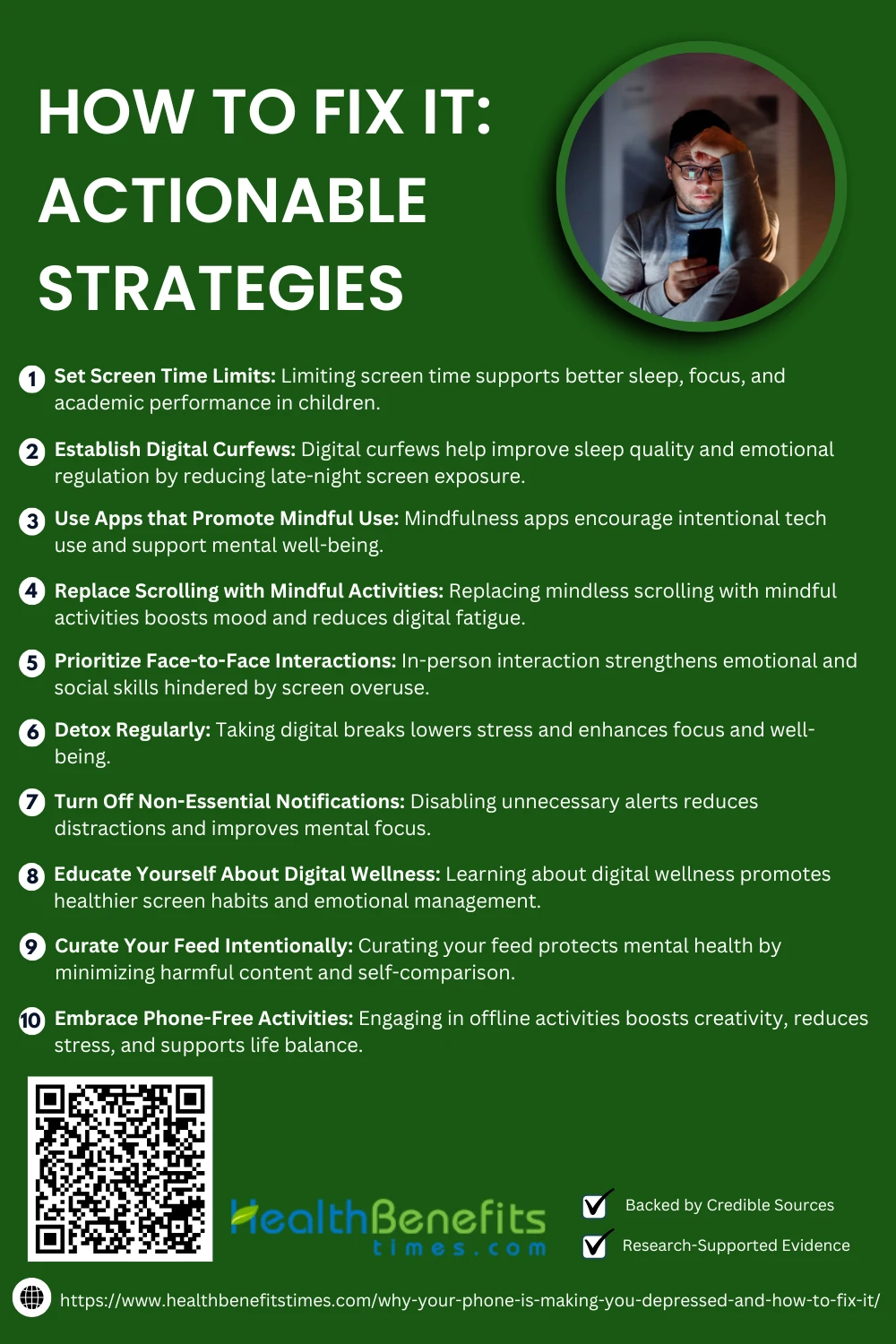- A phone is a portable electronic device used for communication, entertainment, and managing daily tasks, often serving as an extension of our personal lives.
- Excessive phone use, especially social media, can contribute to anxiety, low self-esteem, and depression, often by fostering unhealthy comparisons and overwhelming content consumption.
- Setting boundaries, curating your digital environment, and incorporating phone-free zones can help reclaim your mental health, reducing the negative effects of constant connectivity.
 A phone is a portable electronic device that allows for wireless communication, multimedia interaction, and digital connectivity through various applications and platforms. While smartphones have become indispensable tools for communication and productivity, an increasing body of research suggests that excessive phone use—especially for social media and entertainment—may be harming our mental health. Studies have linked higher screen time with increased symptoms of anxiety and depression, particularly among adolescents and young adults. For instance, one study found that individuals who spend more than five hours a day on their phones are significantly more likely to report depressive symptoms compared to those who use them less. Moreover, the constant exposure to curated, idealized online lives on social media can trigger feelings of inadequacy, loneliness, and low self-esteem, which are key indicators of depression. However, the good news is that mindful usage, digital detox strategies, and setting boundaries around screen time have shown promise in reducing these adverse effects. Understanding how digital habits affect our psyche is the first step toward creating a healthier relationship with our devices.
A phone is a portable electronic device that allows for wireless communication, multimedia interaction, and digital connectivity through various applications and platforms. While smartphones have become indispensable tools for communication and productivity, an increasing body of research suggests that excessive phone use—especially for social media and entertainment—may be harming our mental health. Studies have linked higher screen time with increased symptoms of anxiety and depression, particularly among adolescents and young adults. For instance, one study found that individuals who spend more than five hours a day on their phones are significantly more likely to report depressive symptoms compared to those who use them less. Moreover, the constant exposure to curated, idealized online lives on social media can trigger feelings of inadequacy, loneliness, and low self-esteem, which are key indicators of depression. However, the good news is that mindful usage, digital detox strategies, and setting boundaries around screen time have shown promise in reducing these adverse effects. Understanding how digital habits affect our psyche is the first step toward creating a healthier relationship with our devices.
The Connection between Phone Use and Depression
Recent studies have shown a clear correlation between excessive smartphone use and heightened levels of anxiety, stress, and depression. For instance, a longitudinal analysis by Twenge et al. found that adolescents who spent more than three hours per day on screens were significantly more likely to report depressive symptoms and suicidal ideation than those who used screens less frequently. One mechanism underlying this trend is the dopamine-driven reward loop. Platforms like Instagram and TikTok are engineered to exploit the brain’s reward system—likes, comments, and notifications provide intermittent reinforcement that keeps users returning, similar to how slot machines trigger compulsive behavior. This behavior mirrors characteristics of other addictions: compulsive use, tolerance buildup, and withdrawal-like symptoms when not engaged, as confirmed by a systematic review on smartphone addiction. The patterns are alarmingly parallel to those seen in substance and gambling dependencies.
The Mental Health Traps in Your Pocket
Your phone may seem like a harmless tool, but it’s full of hidden mental health traps. From constant social media comparisons to information overload, these traps can deeply impact your well-being.
Doomscrolling refers to the compulsive consumption of negative news and distressing social media content. It’s especially prominent during times of crisis, where users find themselves unable to stop scrolling through alarming updates. This behavior overstimulates the brain’s threat detection system, heightening feelings of fear and anxiety. Over time, it creates a perception that the world is consistently unsafe, which can contribute to chronic stress and depressive thinking patterns.
2. The Comparison Trap
Social media often showcases carefully curated images and stories from people’s best moments—vacations, achievements, parties—rarely the full, authentic picture of everyday life. This selective portrayal fuels unrealistic comparisons, leading users to feel inadequate or unsuccessful. Constant exposure to others’ “highlight reels” has been linked to lower self-esteem, increased body dissatisfaction, and even symptoms of depression, particularly among teens and young adults.
3. Notification Anxiety
Every ping, buzz, or flash from your phone acts as a mini-alert to your nervous system. These interruptions, though seemingly minor, accumulate stress by constantly pulling your attention away from the present. This type of hypervigilance causes “notification anxiety,” a persistent, subconscious fear of missing something important. Over time, it shortens attention span, increases irritability, and makes it harder to disconnect and relax—even during downtime.
4. Sleep Disruption
Using your phone late at night, especially while in bed, interferes with the natural production of melatonin—a hormone critical for sleep. The blue light emitted from screens disrupts circadian rhythms, making it difficult to fall and stay asleep. Poor sleep isn’t just about feeling tired; it’s directly linked to mood disorders. Chronic sleep disruption is a well-documented risk factor for anxiety, irritability, and clinical depression.
5. Digital Overload and Burnout
Switching between apps, checking messages, reading headlines, and watching reels—all within minutes—fragments attention and overtaxes cognitive resources. This “digital multitasking” can lead to mental fatigue, a type of burnout that leaves you feeling emotionally drained without doing anything physically demanding. The brain’s constant switching takes a toll on memory retention, productivity, and emotional stability.
6. Fear of Missing Out (FOMO)
Seeing others engage in exciting events or social activities—especially when you’re not included—can provoke intense feelings of exclusion or loneliness. This phenomenon, known as FOMO, is amplified by constant access to social media. It’s been associated with compulsive checking behavior, dissatisfaction with real-life social experiences, and increased vulnerability to anxiety and depression.
7. Validation Loop
Many apps are built to keep users returning by offering rewards—likes, shares, comments—that release dopamine, the brain’s “feel good” chemical. This creates a reward loop where users become hooked on seeking external approval to feel worthy. Over time, this can damage self-worth, as confidence becomes tied to digital affirmation rather than internal validation.
8. Mindless Distraction
Phones often serve as an escape from boredom, loneliness, or negative thoughts. While this can offer short-term relief, the habit of turning to your phone during emotional discomfort avoids necessary emotional processing. Over time, this avoidance can worsen symptoms of anxiety and depression, as unaddressed issues accumulate and self-awareness diminishes.
Signs Your Phone May Be Impacting Your Mental Health
Feeling anxious, unfocused, or constantly drained? Your phone might be to blame. Subtle signs of digital overload often go unnoticed—but they could be quietly taking a toll on your mental health.
 1. Increased Anxiety and Stress
1. Increased Anxiety and Stress
Frequent smartphone use can trigger chronic anxiety and stress due to overstimulation and constant alerts. Studies show that excessive screen time heightens cortisol levels and disrupts emotional regulation, while overchecking behavior has been linked with increased psychological distress. (1) Digital dependency may exacerbate symptoms of anxiety disorders, especially in adolescents and college students. (2) (3)
2. Sleep Disturbance
Smartphones emit blue light that interferes with melatonin production, disrupting sleep quality. Late-night scrolling has been shown to delay REM cycles and reduce overall rest. Adolescents using phones before bed often experience insomnia and fatigue. (4) Evening screen use increases alertness, making it harder to wind down. (5) Studies also show that poor sleep from phone use is linked to depression. (6)
3. Withdrawal from Real-Life Social Interaction
Heavy smartphone usage is linked to reduced face-to-face communication, fostering social withdrawal. Young adults who prioritize digital over physical interaction show increased loneliness and weakened relationship quality. (7) Prolonged screen time often replaces meaningful social contact. (8) Research from UCLA indicates screen dependency can blunt social skill development. A study by Northwestern University confirms a decline in empathy with higher mobile engagement, echoing findings from the University of Essex.
4. Mood Swings and Irritability
Mood instability and increased irritability are common effects of smartphone overuse. Studies show digital dependence elevates emotional reactivity due to dopamine sensitivity and overstimulation. ({% trusted %}) According to Boston Children’s Hospital, phone overuse activates the brain’s reward system in ways similar to addictive substances. The American Psychiatric Association links frequent use to irritability in teens. MIT research ties digital fatigue to mood disturbances. Finally, a Stanford study found mood regulation challenges correlated with high screen time. (2)
5. Low Self-Esteem and Comparison Fatigue
Smartphone use, especially on social media platforms, amplifies comparison-based stress, often leading to diminished self-worth. Constant exposure to idealized lives creates unattainable standards, fueling low self-esteem. (9) APA notes that social media use increases self-consciousness. (8) According to University of Pennsylvania, limiting social media lowers negative self-perception. UCLA also links social validation online to adolescent self-esteem dips. Columbia Psychiatry highlights emotional exhaustion caused by constant comparisons.
6. Decreased Productivity
Smartphones fragment attention spans, reducing productivity by disrupting cognitive flow. According to Harvard Business Review, even the presence of a smartphone lowers performance on complex tasks. (10) The University of Texas found that phones diminish working memory and problem-solving ability. Stanford University reports multitasking with phones leads to frequent task-switching, reducing output. (11) MIT and NIH studies confirm similar impacts across educational and workplace environments. (12)
7. Depressive Thoughts or Emotional Numbness
Excessive smartphone use can lead to emotional desensitization and persistent depressive symptoms. Continuous scrolling reduces emotional responsiveness, a phenomenon known as “emotional blunting”. (13) Brown University links smartphone overuse to heightened risk of depression among young users. A University of Michigan study found a strong connection between social media use and reported sadness. Penn State found passive phone use contributes to helplessness. Yale Medicine warns that screen overstimulation dulls emotional processing.
8. Overdependence on External Validation
Phones often turn into tools for constant approval-seeking, leading to overdependence on digital validation. Users who rely heavily on likes or comments for self-worth show increased vulnerability to mental health issues. (14) APA research highlights the emotional toll of online feedback cycles. (8) According to University of Michigan, external validation lowers intrinsic self-worth. UC Berkeley notes this dependence undermines self-confidence. Columbia Psychiatry links this behavior to long-term dissatisfaction and self-criticism.
How to Fix It: Actionable Strategies
Tired of feeling overwhelmed by your phone? Good news—you don’t need to ditch it completely. These simple, effective strategies can help you reclaim focus, boost mood, and protect your mental health.
Setting screen time limits is an effective strategy to support children’s mental and physical well-being. Research by the American Psychological Association highlights that excessive screen exposure can contribute to heightened stress and poor sleep in young users. (15) Moreover, findings from NCBI show a clear correlation between high screen time and reduced academic performance. (16) The U.S. Department of Education also advises timed use to foster healthier digital habits and improve focus.
2. Establish Digital Curfews
Implementing digital curfews helps regulate evening screen use, improving children’s sleep and cognitive function. According to the National Institutes of Health, late-night screen exposure suppresses melatonin, delaying sleep onset. (17) The APA recommends nighttime device cutoffs to combat emotional dysregulation. (18) Additionally, guidance from the U.S. Department of Education supports curfews as a step toward digital balance and healthier school-day routines.
3. Use Apps that Promote Mindful Use
Mindfulness apps can guide users toward healthier digital habits by encouraging intentional technology use. According to NCBI, such apps reduce anxiety and improve focus among adolescents. (19) The APA supports digital self-regulation tools for promoting mental wellness. (20) Furthermore, the U.S. Department of Education suggests integrating educational apps that teach children digital balance, highlighting their positive role in fostering mindful interaction with technology.
4. Replace Scrolling with Mindful Activities
Replacing passive scrolling with mindful activities like journaling or outdoor play enhances emotional regulation and cognitive health. The APA emphasizes that disengaging from endless scrolling can reduce stress and screen dependency. (21) Studies from NCBI show that alternative activities improve mood and decrease digital fatigue. (22) The U.S. Department of Education encourages families to engage in offline, reflective practices to restore balance in screen-saturated routines.
5. Prioritize Face-to-Face Interactions
Prioritizing face-to-face interactions strengthens children’s social and emotional skills, often hindered by excessive screen time. The American Psychological Association emphasizes that in-person engagement boosts empathy and communication. (23) Studies on NCBI show that digital isolation correlates with decreased social competence. (24) The U.S. Department of Education recommends balanced interaction, stressing that real-world socialization is vital for cognitive and emotional development.
6. Detox Regularly
Regular digital detoxes help reset children’s attention spans, reduce stress, and improve overall wellness. According to NCBI, even short-term detoxes lower anxiety and enhance self-control. (25) The APA notes improvements in mood and attention after structured screen breaks. (26) The U.S. Department of Education encourages detox practices as a strategy for promoting digital literacy and mindful screen usage among young learners.
7. Turn Off Non-Essential Notifications
Disabling non-essential notifications can drastically reduce digital distractions and enhance focus. Research from NCBI confirms that constant alerts contribute to attention fragmentation and cognitive overload. (27) The APA emphasizes that managing digital interruptions improves emotional regulation. (28) The U.S. Department of Education also suggests limiting app notifications as part of broader digital hygiene strategies that foster healthier tech use, especially in learning environments.
8. Educate Yourself About Digital Wellness
Understanding digital wellness equips families with tools to balance screen use effectively. The U.S. Department of Education provides comprehensive resources to guide parents and educators in promoting healthy tech habits. According to NCBI, informed individuals are more likely to adopt mindful digital behaviors. (29) The APA further stresses digital literacy as essential for managing emotional well-being and online decision-making. (30)
9. Curate Your Feed Intentionally
Intentionally curating your social media feed helps reduce exposure to harmful content and enhances mental well-being. The APA highlights that following positive, inspiring accounts improves emotional health. (31) Research from NCBI shows that unfiltered feeds can lead to anxiety and self-comparison. (32) The U.S. Department of Education recommends digital literacy training, including feed management, as a key component of responsible and mindful online engagement.
10. Embrace Phone-Free Activities
Engaging in phone-free activities supports cognitive refreshment and meaningful connections. According to NCBI, device-free time enhances creativity and reduces stress levels. (33) The American Psychological Association supports unplugged routines as a means to restore focus and improve well-being. (34) The U.S. Department of Education encourages outdoor play, reading, and physical activities to reduce overdependence on screens and promote balanced lifestyles in both children and adults.
When to Seek Help
Knowing when to seek help is crucial if digital use begins to interfere with daily life, relationships, or mental health. The American Psychological Association advises intervention when screen time disrupts sleep, mood, or academic performance. (35) According to NCBI, signs such as withdrawal, irritability, or compulsive use indicate possible digital addiction. (36) The U.S. Department of Education stresses involving mental health professionals when digital behaviors impact learning or emotional well-being.
Conclusion
In conclusion, while your phone offers convenience and connection, its impact on mental health is undeniable. From constant social media comparisons to information overload, the effects can be subtle but significant. However, the good news is that small, intentional changes can make a big difference. By setting boundaries, curating your digital spaces, and prioritizing real-world interactions, you can regain control over your phone’s influence on your life. Remember, you don’t need to go off the grid to protect your mental health—just find a healthy balance. Taking action today can lead to a happier, more focused tomorrow.




